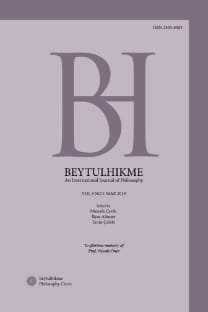The Role and Importance of Schematism in the Critique of Pure Reason
The Role and Importance of Schematism in the Critique of Pure Reason
This article focuses on Transcendental Schematism in the Critique of Pure Reason. Schematism has the utmost importance for the explanation of the deduction of the categories, and application of the pure concepts to experience. As the material of sensibility and understanding are heterogeneous, schematism bears the vital role of rendering them homogeneous for the possibility of cognition. Thus, schematism both elucidates the structure of the determinate judgments and the ground of transcendental philosophy by subtly building a bridge between the sensibility and understanding. Despite its significance, schematism is often criticized for its difficulty and incomprehensibility. In this context, this study aims to illuminate the structure of schematism and underline the importance of it for transcendental philosophy as it is presented by Kant in the Critique of Pure Reason.
___
- Allison, H. E. (2004). Kant’s Transcendental Idealism: An Interpretation and Defense, New Haven: Yale University Press.
- De Boer, K. (2018). Kant’s Account of Sensible Concepts in the Inagural Dissertation and the Critique of Pure Reason, Natur und Freiheit. Akten des XII. Internationalen Kant-Kongresses, Ed. Violetta Waibel, Margit Ruffing, David Wagner, Berlin: De Gruyter https://doi.org/10.1515/9783110467888-021, 1015-1022
- Gözkân, H.B. (2018). Kant’ın Şemsiyesi, İstanbul: Yapı Kredi Yayınları. Hanna, R. (2001). Kant and the Foundations of Analytic Philosophy, Oxford: Clarendon Press
- Hanna, R. (2006). Kant, Science and Human Nature, Oxford: Clarendon Press
- Heidegger, M. (1997). Phenomenological Interpretation of Kant’s Critique of Pure Reason.
- Çev. Parvis Emad ve Kenneth Maly, Indianapolis: Indiana University Press Kant I. (2005). Notes and Fragments, Ed. Paul Guyer, New York: Cambridge University Press.
- Kant, I. (1992), Theoretical Philosophy 1755-1770, Cambridge: Cambridge University Press,
- Kant, I. (1999). Correspondence, Çev. ve ed. Arnulf Zweig, Cambridge: Cambridge University Press.
- Kant, I. (2007). Critique of the Power of Judgement, Çev. Paul Guyer, Eric Matthews, New York: Cambridge University Press.
- Kant, I. (2009). Critique of Pure Reason, Çev. Paul Guyer, Allen W. Wood, New York: Cambridge University Press.
- Kovanlıkaya, A. (2014). Tezahürleri Sahiden Bilebilir miyiz? Kant Özel Sayısı, Felsefi Düşün, Sayı: 3, 35-54
- Krämer S. (2018). Schematism, Imagination, and Pure Intuition, Image, Imagination, and Cognition, Ed. Christoph Lüthy, Claudia Swan, Paul Bakker, Claus Zittel, Brill Publishing, Leiden
- Kuehn, M. (2017). Immanuel Kant, Çev. Bülent O. Doğan, İstanbul: İş Bankası Kültür Yayınları
- Paton, H.J. (1936) Kant’s Metaphysics of Experience, Londra: George Allen & Unwin Ltd.
- Shaper, E. (1964). Kant’s Schematism Reconsidered. Review of Metaphysics. Cilt:18, Sayı: 2, 267:292
- Woods, M. (1983). Kant’s Transcendental Schematism. Dialectica, 37(3), 201:219
- ISSN: 1303-8303
- Başlangıç: 2011
- Yayıncı: Mustafa Çevik
Sayıdaki Diğer Makaleler
Maria BLIKHAR, Oksana DUFENIUK, Viacheslav BLIKHAR
Çağdaş Analitik Epistemolojiye (veya Gettierolojiye) Metodolojik Bir Eleştiri: Poppercı Yaklaşım
Tarski's Semantic Definition of Truth
Türk Milli Eğitiminin Amaçlarında Birey ve Vatandaş Sorunu
Evaluation of Spinoza's Concept of Freedom in the Light of Neuroscientific Experiments
Ambiguity, Dissensus and Subjectification: Antigone
Why Study Medieval Philosophy?
